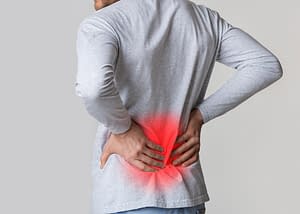People often ask what they can do to keep their low back and general spine healthy and functioning well.
Low back pain is the most common cause of pain and disability across the world. In the western world, particularly here in the UK, low back pain is the main reason people are absent from work and it’s a main cause for most people in their life. However, it is reassuring to know that most low back and spinal pain is not dangerous and is not linked to any sinister pathology such as cancer or other worrying conditions. It is in fact a very common and usually self-healing problem.
The Myth of Rest and The Power of Movement

There are many things you can do to reduce the risk of developing low back pain and to keep your spine as healthy and happy as possible. The first and most important thing is to keep the spine regularly moving. The old-fashioned advice around resting was given to people thirty to forty years ago when you have back pain. However, through research, this has been shown to be incorrect. There have been hundreds of research trials now showing that movement is the key positive factor when it comes to improving low back pain symptoms.
Of course, if you have acute low back pain or spasm and are unable to move due to an injury, then an element of relative rest for a day or two is advisable, once the symptoms have subsided. It has been shown that gentle increasing of little movement around the spine, legs and back can help speed up recovery and ensure that it is sustainable and progressive.
Managing Acute Back Pain
When someone has an episode, particularly an acute episode of low back pain, (acute in this context means a very new, unpleasant and often severe episode of pain), they can often feel unable to move in certain positions. For example, they are unable to bend forward or lay down flat, which is often due to muscular spasm of the protective muscles that sit around holding the spine still. Once the acute spasm reduces, which will happen with time or perhaps with the use of some medications to reduce pain inflammation and muscular spasm, that’s when the gentle and progressive increase in movement needs to occur.

Unfortunately, pain, particularly low back pain, can cause people to worry about doing further damage, which then prevents any normal movement. What this does is increase the muscular spasm – the tension and tightness that structures around the spine – which slows the healing and maintains a regular level of pain. Whereas, if someone was to move more regularly and keep stretching as the body recovers, the muscles relax the joints to become more flexible and alleviate pain. It’s always worth talking to a physiotherapist to get an expert opinion and advice to manage acute episodes of back pain as effectively and safely as possible.
Preventing Back Pain

In preventing low back pain, there is no singular thing you can do other than maintain regular movement, which can involve simple things like reaching down to the floor with the knees bent and arching your back slightly. For alternative movements, this can be achieved through more structured exercises like yoga, Pilates, swimming, regular walking or any general exercise which you enjoy doing.
The Benefits of Exercise
Furthermore, research shows one exercise is not necessarily superior to another. Therefore, if you enjoy line dancing, aerobics, or weightlifting, all of these are positive when it comes to supporting your back and reducing the risk of low back pain, as well as associated symptoms including sciatica. As with any exercise advice, starting gently and building up over time to build up the body’s tolerance and adaptation to the exercise is the best way. Sometimes, back problems can be triggered by jumping into a new form of exercise without giving the spinal soft tissues and structures time to adapt to that new exercise pressure.

There has been some excellent research on the impact of running while having low back pain. Historically, we might have thought that running was bad for the lower back. However, repeated research shows that the increased possibility of low back pain is not linked to running. Indeed, there is some good research showing that running any distance has a protective effect on the back and many joints within the body. Again, if you’re considering increasing your exercise routine or changing things, advice from a musculoskeletal physiotherapist would be sensible to ensure you’re doing all you can to maximise the health of your spine.
Genetic factors and your overall health

There are several other factors to consider when looking at maintaining a healthy spine, some of which are out of your control. For example, there is an increasing link between genetic predisposition and low back pain, meaning individuals are more likely to experience low back pain if their parents also had it. This is particularly true of disc and arthritic related low back pain. However, there are many mitigating activities and lifestyle choices you can make to reduce this risk, for example, regular movement, exercise with a healthy diet, and not smoking.
Author – Phin Robinson, Founder & Director of Pure Physiotherapy.
Pure Physiotherapy can support you with any musculoskeletal concerns you may have. Our clinics located throughout the UK are here to help. Find the nearest clinic to you and book an appointment online.